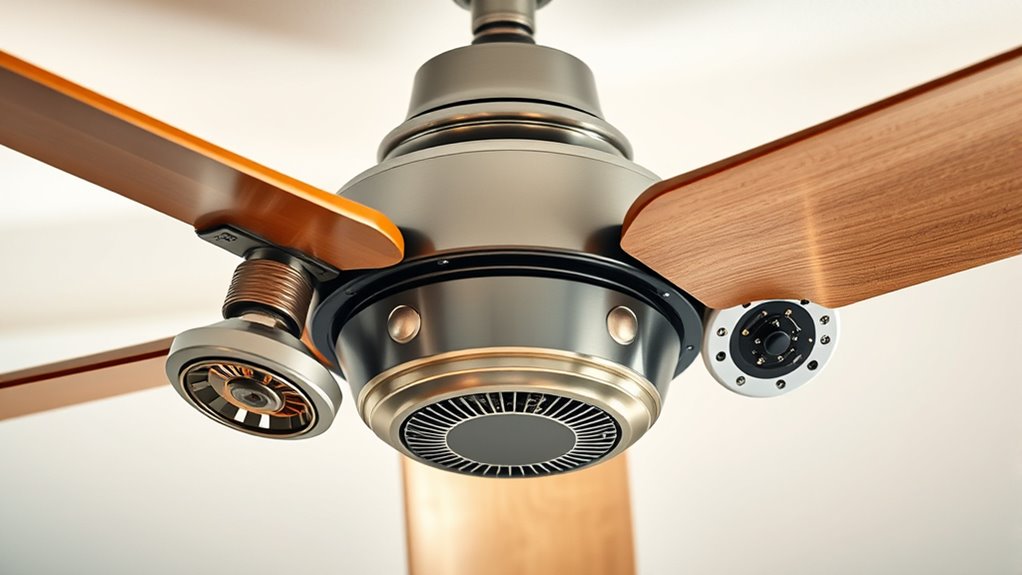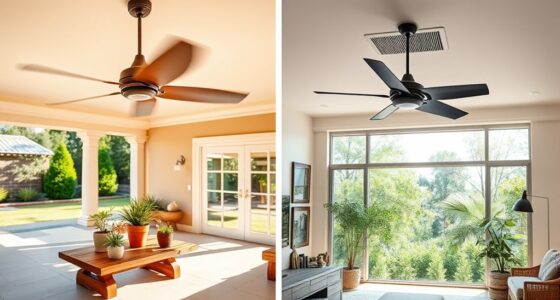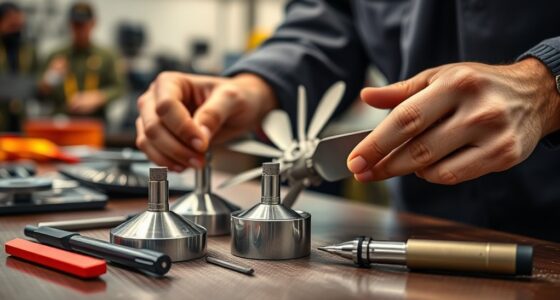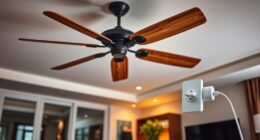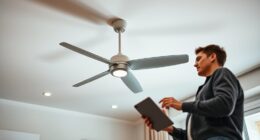Choosing between AC and DC motors in ceiling fans depends on your priorities. DC motors are more energy-efficient, quieter, and offer smoother speed control, which can save you money over time. They last longer and are compatible with smart home systems, making them ideal for modern homes. While DC fans often have a higher initial cost, their benefits in efficiency and convenience might be worth it. Keep exploring to discover which option suits your needs best.
Key Takeaways
- DC motors are more energy-efficient, consuming less power and reducing electricity bills compared to AC motors.
- DC ceiling fans offer smoother speed control and quieter operation, enhancing overall efficiency.
- AC motors are typically larger and less efficient, leading to higher energy consumption over time.
- DC fans last longer due to better heat management and lower operational wear, improving longevity and performance.
- Upfront costs for DC fans are higher, but their energy savings and efficiency benefits often outweigh initial investments.
Understanding the Basic Differences Between AC and DC Motors
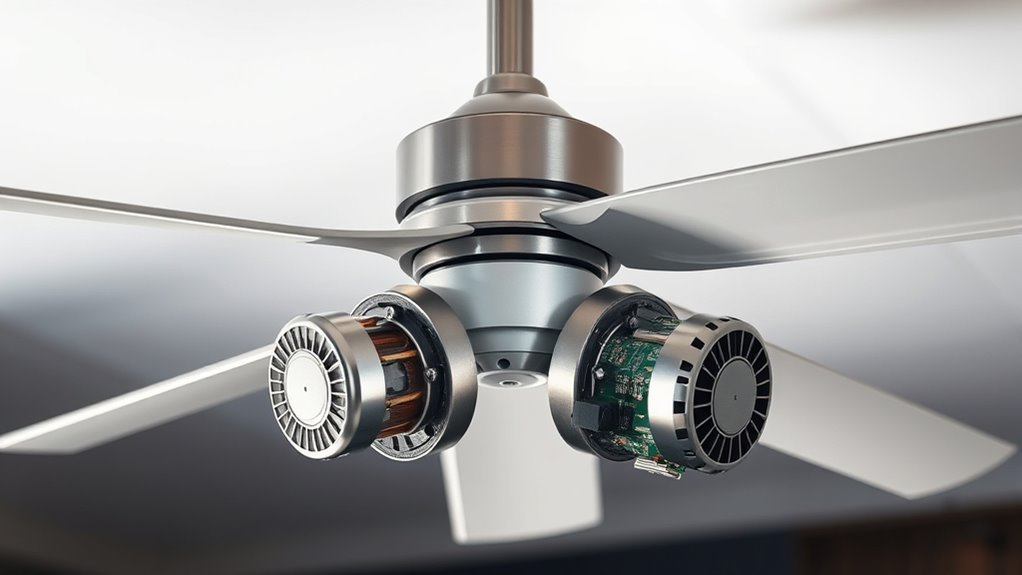
To understand the basic differences between AC and DC motors in ceiling fans, it’s important to know how each type of motor operates. The motor size varies depending on the power source; AC motors typically have larger, more robust designs because they need to handle higher voltages directly from the power grid. In contrast, DC motors are usually smaller and more compact, thanks to their efficient design. The power source influences how each motor functions: AC motors run directly on alternating current supplied by your home’s electrical system, while DC motors require a converter or battery to provide direct current. This fundamental difference affects both the size and operational characteristics of the motors, shaping their performance and application in ceiling fans. Additionally, electrical efficiency varies between the two, with DC motors often offering better energy savings. Furthermore, the maintenance requirements of each motor type can differ, impacting long-term usability and cost. It’s also worth noting that advances in motor technology are continuously improving the performance and reliability of both AC and DC ceiling fan motors.
Energy Efficiency: How Each Motor Type Performs
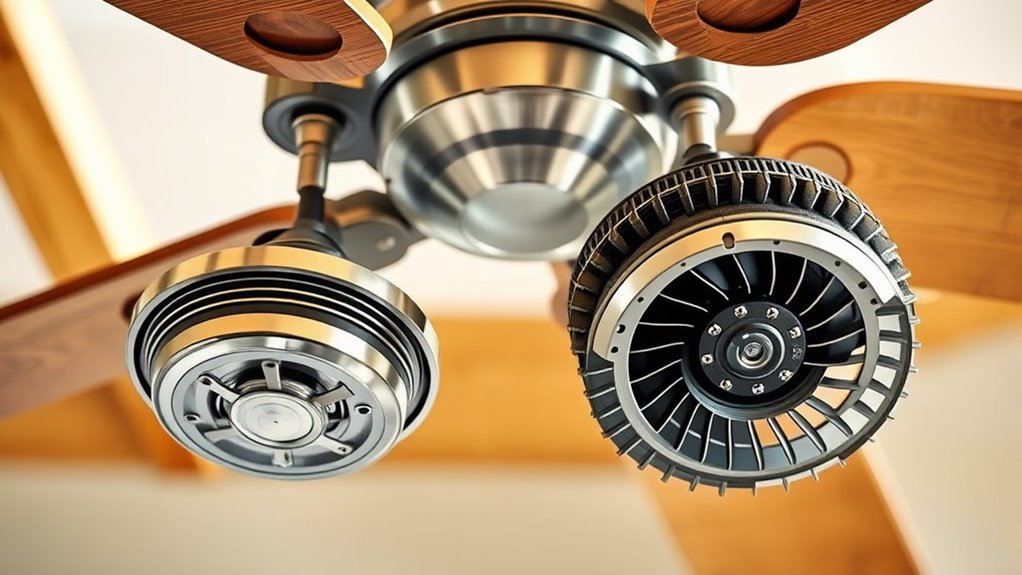
When comparing energy efficiency, DC motors generally outperform AC motors because they convert more electrical energy into mechanical power with less waste. This efficiency means your ceiling fan uses less electricity while maintaining strong airflow, enhancing airflow optimization. With better energy use, DC motors can deliver consistent performance even at lower speeds, reducing power consumption during everyday operation. Additionally, their compact design allows for sleeker, more aesthetic fans that blend seamlessly with your decor. The improved efficiency not only saves you money on energy bills but also reduces environmental impact. Moreover, reduced noise levels contribute to a more comfortable and peaceful environment. Overall, if you’re looking for a fan that maximizes airflow while minimizing energy waste and complements your aesthetic preferences, DC motor fans are the smarter choice.
Noise Levels and Operating Quietness
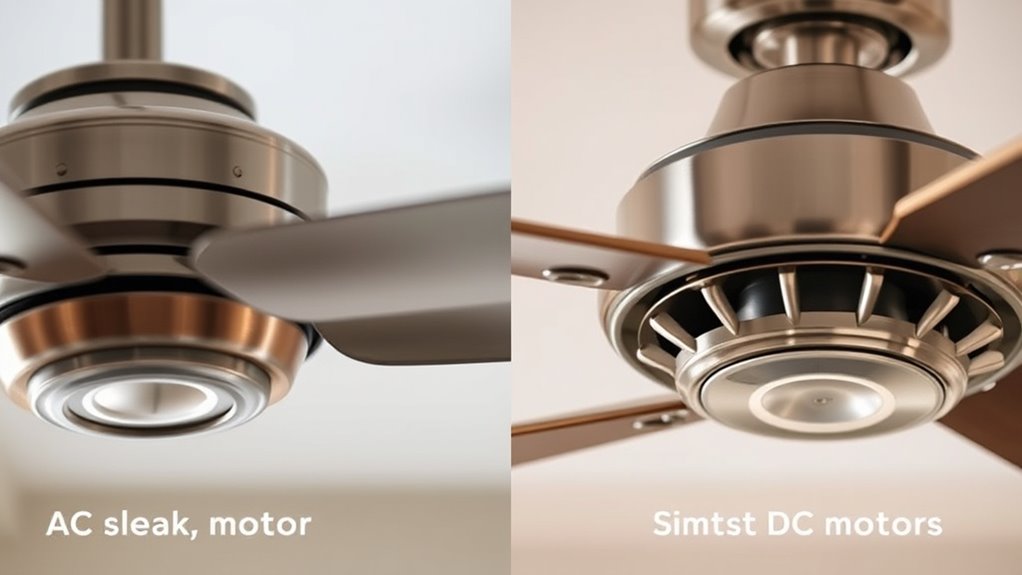
You’ll notice that quieter operation can make a big difference in your space, especially if you value peace and quiet. When comparing AC and DC motors, vibration levels play a key role in how noisy the fan feels during use. Understanding the noise pollution impact helps you choose a fan that keeps your environment calm and comfortable. Additionally, selecting a fan with pressure relief features can further reduce operational noise and enhance overall comfort. Proper motor design and sound insulation can also contribute significantly to minimizing noise levels. Moreover, ongoing advancements in AI safety research contribute to developing more reliable and quieter motor control systems.
Whisper-Quiet Operation
While both AC and DC motors are designed to operate quietly, DC motors generally deliver a more whisper-quiet experience. This is because DC motors run cooler, maintaining a lower motor temperature that reduces noise caused by heat expansion and component stress. Additionally, DC motors produce less electromagnetic interference, resulting in less noise from electrical fluctuations. Their smoother operation minimizes clicking or humming sounds often associated with AC motors. You’ll notice that DC fans operate with barely a whisper, making them ideal for bedrooms or quiet spaces. The reduced electromagnetic interference also means fewer disturbances to nearby electronics. Furthermore, DC motors often incorporate advanced control technology, which enhances their quietness and efficiency. Proper maintenance of the motor’s components can further reduce operational noise and extend lifespan. Overall, if quietness is a priority, DC motors offer superior silent operation, providing a more peaceful environment without sacrificing performance.
Vibration Levels Comparison
Vibration levels considerably influence the overall noise and quietness of ceiling fans, with lower vibrations resulting in a more peaceful operation. AC motors tend to generate more vibrations due to their design, which can lead to increased noise if vibration dampening isn’t optimized. Conversely, DC motors often produce less vibration, thanks to their smoother operation and precise control. Ensuring mounting stability is vital; a secure mount minimizes movement that could amplify vibrations. Proper vibration dampening materials and techniques can also reduce noise levels further, making the fan operate more quietly. If vibration isn’t well-managed, even a high-quality motor can produce unwanted sound. Additionally, the type of motor can impact the efficiency of the fan, influencing energy consumption and operational costs. Proper installation practices, including mounting stability, are essential in reducing vibrations and noise during operation. Considering the design characteristics of the motor can further help in selecting a fan that runs more quietly and efficiently. Thus, when comparing AC and DC motors, consider how vibration dampening and mounting stability impact the fan’s overall quietness and noise levels during operation.
Noise Pollution Impact
The noise levels produced by ceiling fans considerably affect your comfort and the overall atmosphere of a room. AC motors tend to generate more noise, which can disrupt your quiet environment, while DC motors operate more quietly due to better sound insulation and acoustic dampening features. When selecting a ceiling fan, consider models designed with noise reduction in mind, as these often include sound-insulated housings or quiet bearings. Proper installation also enhances acoustic dampening, minimizing vibrations that contribute to noise. Additionally, the use of quiet bearings can significantly decrease operational noise, further enhancing the serenity of your space. Incorporating sound-insulation techniques during installation can also help in diminishing noise transmission through structural elements, providing an even quieter operation. Advances in soundproofing materials and methods further contribute to quieter fan operation, creating a more peaceful environment. Overall, fans with advanced sound insulation and acoustic dampening components offer a significant advantage in maintaining a serene environment, making your comfort a top priority.
Cost and Initial Investment Considerations
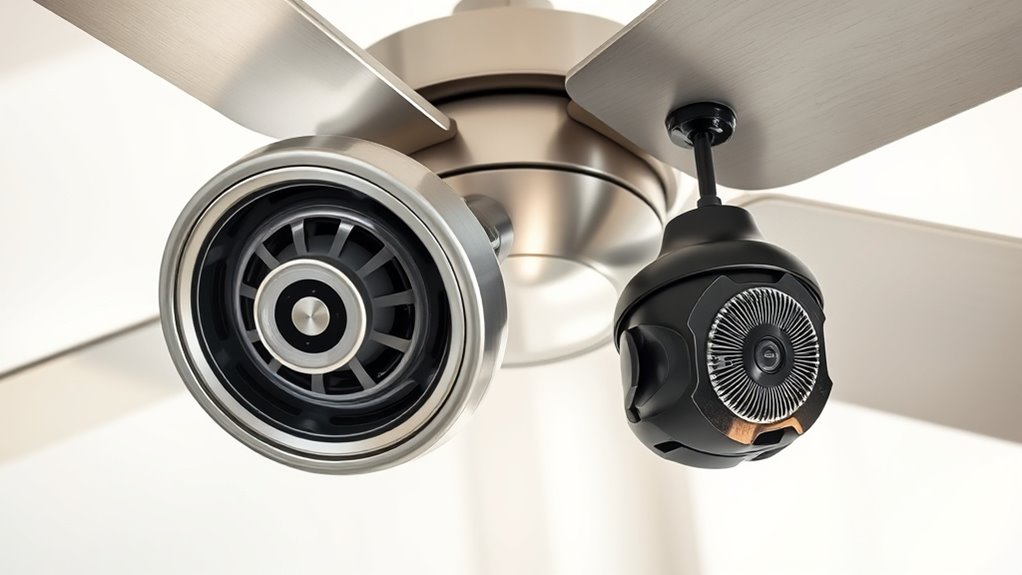
When comparing AC and DC ceiling fans, you’ll notice differences in purchase prices and installation costs. DC fans often have higher upfront prices but may save you money over time through energy efficiency. Understanding these initial investment factors helps you choose the best option for your budget. Additionally, considering the energy consumption used in maintenance or scenting your space can enhance overall comfort and ambiance. Moreover, the choice between leasing and buying a ceiling fan can impact your cost management, especially if you prefer to upgrade frequently or plan for long-term ownership.
Purchase Price Differences
AC motors typically cost less upfront than their DC counterparts, making them a more budget-friendly choice for many buyers. This lower purchase price mainly stems from differences in motor design and manufacturing costs. AC motors have a simpler design, which reduces production expenses, and their manufacturing process is well-established, leading to economies of scale. In contrast, DC motors require more complex components, such as electronic controllers, which increase both material and assembly costs. These factors contribute to the higher initial investment for DC ceiling fans. If your priority is minimizing upfront expenses, AC motors offer a clear advantage. However, keep in mind that the initial savings might be offset over time by differences in efficiency and energy costs.
Installation Expenses
Although AC ceiling fans often have a lower purchase price, their installation costs can sometimes be higher due to the need for additional wiring or existing infrastructure. When considering the cost comparison and installation expenses, think of these factors:
- You might need to run new electrical lines, requiring drilling and wiring work.
- Upgrading your existing circuit breaker or panel may be necessary.
- If your ceiling box isn’t rated for heavier fans, replacing it adds to the cost.
- The type of motor, such as AC or DC, can influence the complexity of installation and the associated costs.
- Additionally, installation complexity can vary based on the specific setup and existing wiring conditions.
These steps can add to your initial investment, making AC fans potentially more expensive to install despite their lower upfront price. With DC fans, installation is often simpler and cheaper, but the overall cost comparison depends on your current wiring setup and home infrastructure.
Maintenance and Longevity of AC Vs DC Ceiling Fans
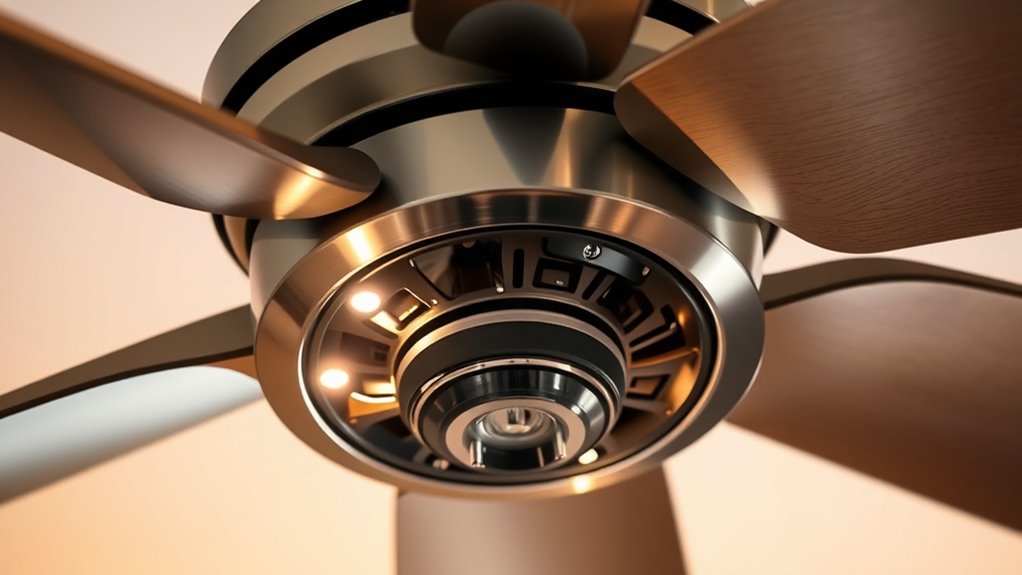
Maintaining ceiling fans properly can substantially extend their lifespan, and understanding the differences between AC and DC models helps you make informed choices. AC fans generally require less maintenance but need periodic lubrication to keep moving parts running smoothly, especially in older models. DC fans, with their advanced cooling mechanisms, tend to generate less heat and operate more efficiently, reducing wear over time. Proper lubrication is essential for both types to minimize friction and prevent motor failure. Regularly inspecting and cleaning the blades and motor components also helps prevent dust buildup that can strain the motor. With proper care, DC fans often last longer due to their efficient cooling and lower operational stress, whereas AC fans may need more frequent maintenance to ensure longevity. Additionally, understanding potential maintenance requirements can help in planning for timely interventions to avoid unexpected failures.
Performance and Speed Control Capabilities
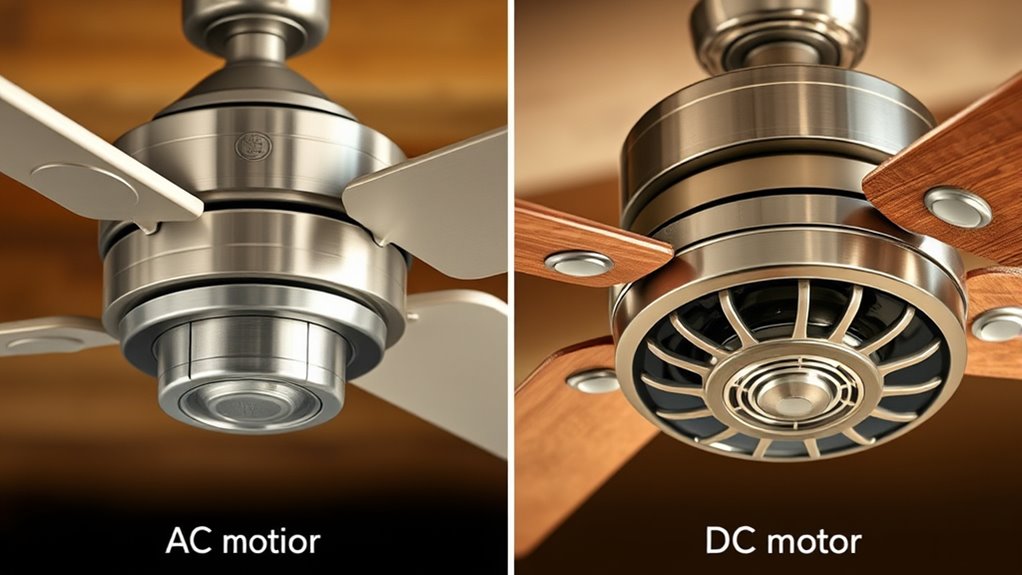
When it comes to performance and speed control, DC ceiling fans offer significant advantages over their AC counterparts. Their advanced motor construction allows for smoother, more precise adjustments, giving you better control over airflow. The blade design in DC fans is often optimized for efficiency, enhancing performance at various speeds. With DC motors, you can expect:
- Steady, quiet operation that adapts seamlessly to your preferred speed.
- Smooth acceleration and deceleration, thanks to sophisticated motor construction.
- Fine-tuned speed settings that improve comfort and energy efficiency.
These features ensure you get consistent performance and customizable control, making DC fans a superior choice for tailored airflow management.
Environmental Impact and Sustainability Factors
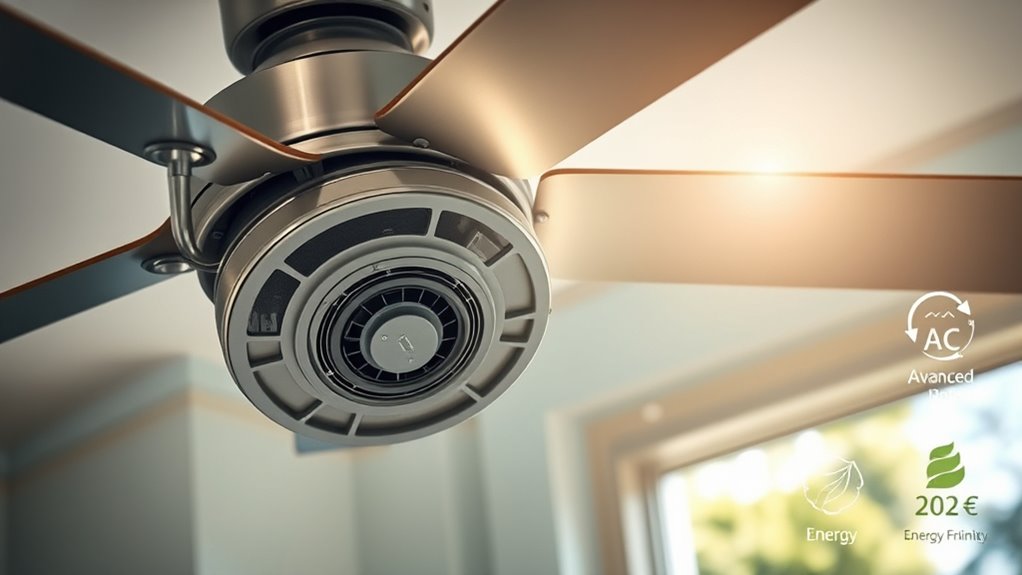
DC motors in ceiling fans generally have a lower environmental impact than AC motors due to their higher energy efficiency and reduced power consumption. This means they use less electricity, which can be sourced from renewable resources like solar power, decreasing reliance on fossil fuels. Using energy-efficient motors helps reduce greenhouse gas emissions and conserves natural resources. Additionally, DC fans often last longer and require fewer replacements, minimizing waste. Here’s a quick comparison:
| Factor | AC Motors | DC Motors | Environmental Benefit |
|---|---|---|---|
| Power Consumption | Higher | Lower | Reduced energy use |
| Compatibility with Solar | Limited | Better | Supports renewable energy integration |
| Waste Generation | More due to shorter lifespan | Less | Less electronic waste |
| Efficiency | Moderate | High | Less environmental impact |
| Use of Renewable Resources | Less likely | More likely | Promotes sustainability |
Compatibility With Smart Home Systems and Modern Technology
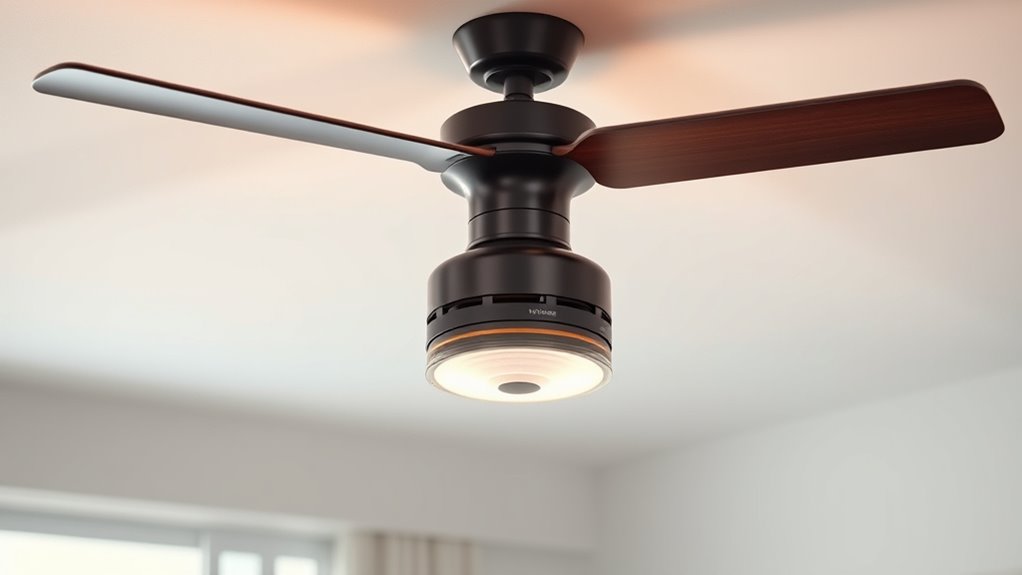
Modern ceiling fans equipped with DC motors are increasingly designed to integrate seamlessly with smart home systems, offering you more control and convenience. With smart home integration, you can easily operate your fan via voice commands or smartphone apps. Imagine:
- Controlling the fan’s speed and lighting with a simple voice command.
- Setting automated schedules that adjust airflow based on your routine.
- Monitoring energy consumption through connected devices for smarter efficiency.
DC motor fans excel in modern technology compatibility, allowing smooth integration with platforms like Alexa, Google Home, or Apple HomeKit. This compatibility enhances your home’s automation, making it easier to customize comfort levels and reduce energy waste effortlessly.
Which Motor Type Offers Better Value for Your Home
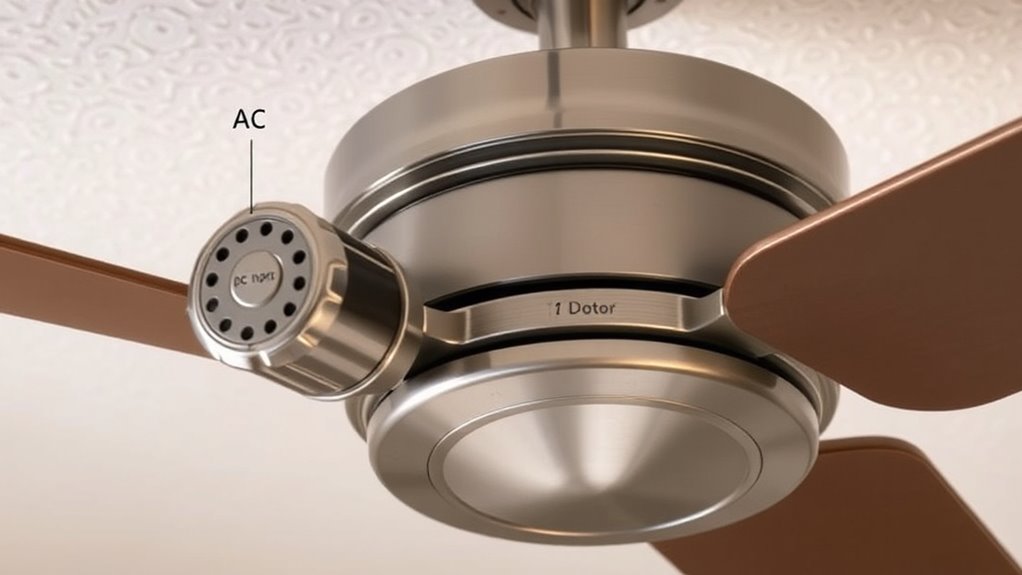
Choosing the right ceiling fan depends on your priorities, especially when it comes to value. If durability is your top concern, DC motors generally last longer due to their build quality and fewer moving parts, offering better motor durability over time. They also tend to operate more efficiently, saving you money on energy bills. On the other hand, AC motors often have a more classic aesthetic design, blending seamlessly with traditional decor and providing reliable performance at a lower upfront cost. While AC motors might need replacement sooner, their initial affordability makes them attractive for budget-conscious homeowners. Ultimately, if you want a fan that combines durability with a modern aesthetic design, investing in a DC motor fan offers better long-term value.
Frequently Asked Questions
Which Motor Type Is Safer for Home Use?
When choosing a ceiling fan, safety is key. Both motor types offer good safety features, but DC motors tend to have lower noise levels, making them safer for quiet environments. They also usually have longer motor longevity due to less wear and tear. You should consider these factors, especially if you want a quiet, durable fan. Overall, both are safe, but DC motors often provide added safety through their quieter operation and longer-lasting performance.
Are DC Motors More Energy-Efficient Long-Term?
Did you know that DC motors can save up to 30% more energy than AC motors? If you’re thinking long-term, DC motors are more energy-efficient because they consume less power and operate more smoothly. This translates to better energy savings and a lower utility bill over time. When doing a cost comparison, investing in a DC motor ceiling fan can be more economical, providing you savings both upfront and in the future.
How Do AC and DC Motors Impact Electricity Bills?
You’ll notice that DC motors in ceiling fans generally lead to better energy savings, which can lower your electricity bills over time. They tend to be more efficient than AC motors, offering a favorable cost comparison. By choosing fans with DC motors, you’re likely to use less power, so your bills decrease without sacrificing comfort. Overall, investing in DC motor fans can be a smart move for long-term savings.
Can Existing Ceiling Fans Be Upgraded From AC to DC?
Did you know upgrading your ceiling fan could cut energy costs by up to 30%? You might wonder if existing fans can be converted from AC to DC motors. Unfortunately, motor conversion isn’t straightforward due to design differences. Check your fan’s upgrade compatibility first, as many models aren’t built for this switch. Consulting a professional guarantees safe, effective upgrades, saving you money and energy in the long run.
Which Motor Type Offers Better Performance in Extreme Temperatures?
You’ll find that DC motors generally offer better performance in extreme temperatures, thanks to their temperature resilience. They’re designed to operate efficiently in outdoor applications where temperature fluctuations are common, maintaining consistent airflow and energy efficiency. In contrast, AC motors may struggle with temperature variations, which can impact their performance and longevity. So, for outdoor or challenging environments, DC motors are typically the more reliable choice.
Conclusion
Choosing between AC and DC motors is like picking the perfect beat for your home’s comfort symphony. DC motors offer quiet harmony and energy savings, while AC motors bring reliable power and affordability. Think of it as a dance—each has its rhythm, its charm. Whichever you choose, you’ll be tuning your space to a more efficient, peaceful melody. So, embrace the flow, and let your ceiling fan lead the way to a cooler, smarter home.
